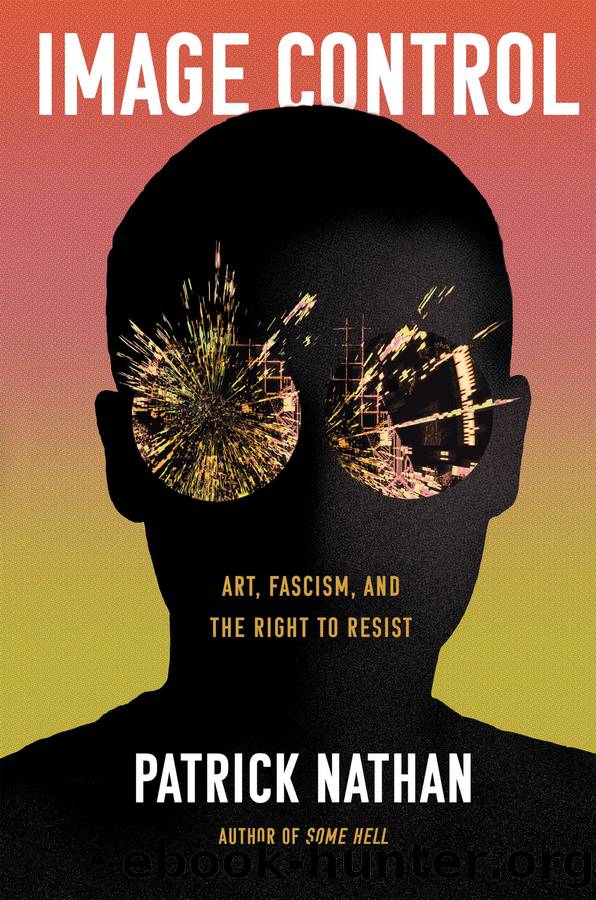Image Control by Patrick Nathan

Author:Patrick Nathan
Language: eng
Format: epub
ISBN: 9781640094543
Publisher: Catapult
Published: 2021-05-26T00:00:00+00:00
Photography is a technologyâwhich is to say, itâs not a weapon. Itâs not, in a strict sense, Barthesâs âagent of death,â even if it does trade in images of death. Even if it does promise, in some way, to bring something of its subjects into a time they cannot follow. Photography is hardly the first technology to promise transcending the boundaries of oneâs own lifeâof reaching beyond the âbrief crack of light,â as Nabokov called it, âbetween two eternities of darknessââand, of course, hardly the last. Yet there remains something about it that most of us, including those who surveil themselves with thousands of photographs every year, are unable to see.
In her essay âKim Kardashian West Is the Outsider Artist America Deserves,â Laura Jean Moore describes how female self-portraiture âupends historical norms of female representation and power, and places the power of depiction squarely in the hands of the subject.â In assuming herself and her life as a subject, âKardashian West is part of an established legacy of female artists and writers who have created art from the realm of the intensely personal and confessional.â Via Instagram, Kardashian West narrates her self in carefully selected images with total artistic agency. Her story is one of empowerment, beauty, andâstrangely enough, via a distortion of the selfâself-acceptance. (Naturally, she rarely mentions the immense, uncirculated stockpile of wealth and resources that enable such self-acceptance, nor how much capital and labor is expended by her and her employees to arrive at such selfies.)
Kardashian Westâs photographic project seems an inversion of Cindy Shermanâs, who has long suppressed the personal and the confessional despite her physical body being the subject of almost all her work. In âA Piece of the Action: Images of âWomanâ in the Photography of Cindy Sherman,â Judith Williamson argues that Sherman adapts the traditional uses of women in art, journalism, and advertising as divining rods for dominant societal narratives: âAn image of a womanâs face in tears will be used by a paper or a magazine to show by impression the tragedy of war, or the intensity of, say, a wedding. From the face we are supposed to read the emotions in the event.â In Shermanâs Film Stills project, Williamson says, âthe very reference to film invites this interpretation. Film stills are by definition a moment in a narrative. In every still, the woman suggests something other than herself, she is never complete: a narrative has to be evoked.â Instead of highlighting how narrative can imbue a self with agency, Shermanâs oblique personae are deprived of agency. The women in her photographs are victims of narrative, used in someone elseâs story.
In Fetishism and Curiosity, Laura Mulvey suggests that each of Shermanâs images is âa cutout, a tableau suggesting and denying the presence of a story . . . The Film Stills parody the stillness of the photograph and they ironically enact the poignancy of a âfrozen moment.â The women in the photographs are almost always in stasis, halted by something more than photography.
Download
This site does not store any files on its server. We only index and link to content provided by other sites. Please contact the content providers to delete copyright contents if any and email us, we'll remove relevant links or contents immediately.
Kathy Andrews Collection by Kathy Andrews(11709)
The remains of the day by Kazuo Ishiguro(8790)
Paper Towns by Green John(5065)
Spare by Prince Harry The Duke of Sussex(5054)
The Body: A Guide for Occupants by Bill Bryson(4953)
Industrial Automation from Scratch: A hands-on guide to using sensors, actuators, PLCs, HMIs, and SCADA to automate industrial processes by Olushola Akande(4919)
Machine Learning at Scale with H2O by Gregory Keys | David Whiting(4110)
Be in a Treehouse by Pete Nelson(3924)
Never by Ken Follett(3766)
Harry Potter and the Goblet Of Fire by J.K. Rowling(3759)
Goodbye Paradise(3714)
Into Thin Air by Jon Krakauer(3289)
The Remains of the Day by Kazuo Ishiguro(3280)
The Cellar by Natasha Preston(3242)
The Genius of Japanese Carpentry by Azby Brown(3209)
Fairy Tale by Stephen King(3194)
120 Days of Sodom by Marquis de Sade(3161)
The Man Who Died Twice by Richard Osman(2980)
Drawing Shortcuts: Developing Quick Drawing Skills Using Today's Technology by Leggitt Jim(2975)
